2016 Hyundai Sonata Easy to Work on

With all three of my nephews in college, my sister-in-law was ready to get rid of her trusty Toyota Sienna minivan. A schoolteacher on a budget, she wanted a safe, efficient, and reliable midsize car with a low, affordable monthly payment. I recommended the redesigned 2015 Hyundai Sonata, which, at the time, was available with no-interest financing for 72 months. She bought one, white with tan leather, and she loves it.
If you have similar requirements, I'd recommend a Sonata to you, too. With a Sonata, you get more car than you pay for. From its roomy and comfortable interior to its class-leading warranty and roadside-assistance plan, the Sonata just makes sense.
Sensibility isn't sexy, though. Cars are as much about emotion as they are logic, and in this regard, the Sonata falls short.
Subjectively, this Hyundai earns high marks across the board, reflecting the automaker's steadfast approach to employing best-practice design, engineering, and ergonomics in the development of its products. At the same time, the latest version of the Sonata fades into the midsize sedan background, its conservative styling a step backward from the previous-generation version of the Sonata, which exuded visual drama that made it impossible to ignore.
Hyundai sells the 2016 Sonata in SE, Sport, and Limited trim levels with a 185-horsepower, 2.4-liter 4-cylinder engine. A 240-hp, turbocharged 2.0-liter 4-cylinder engine is included for the Sport 2.0T and Limited 2.0T trims. Prices range from an exceptionally reasonable $22,585 from the Sonata SE up to $36,790 for a Limited 2.0T with every single dealer-installed option.
Having spent no more than a few minutes in the spicier Sonata 2.0T since the car's 2015 redesign, I thought I'd see if this turbocharged and sport-tuned version of Hyundai's family sedan might kick things up a notch. My test vehicle arrived in Sport 2.0T trim, in Shale Gray paint, and with nothing more than a set of floor mats as an option. The sticker price came to $29,885, including the $835 destination charge.
Rolling on larger 18-inch aluminum wheels with a unique split-spoke design, my test car was one of the best-looking Sonatas I've seen since the car was redesigned. From the way the wheel finish complemented the paint color to its four rectangular exhaust tips, this Sonata Sport 2.0T looked great, the sole misstep the odd chrome trim beneath the door panels.
Still, this is a conservative design, one shaped by a wind tunnel and the latest evolution of Hyundai's Fluidic Sculpture design language. Cues from the groundbreaking 2011-2014 Sonata are evident, such as the chrome strip connecting the headlights to the greenhouse, the fastback roofline, and the character line running from the front wheels to the taillights. However, with the latest Sonata, the effects are muted rather than dramatic, perhaps in a bid to appeal to a greater number of midsize sedan buyers.
Inside, the Sonata is all grown up. The previous-generation version's narrower, waterfall dashboard design and jarringly discordant puzzle of shapes, seams, and surfaces is replaced by a simple, cohesive, modern, and refined cabin that makes the Sonata look and feel like a more expensive car than it is.
Some might even call it boring.
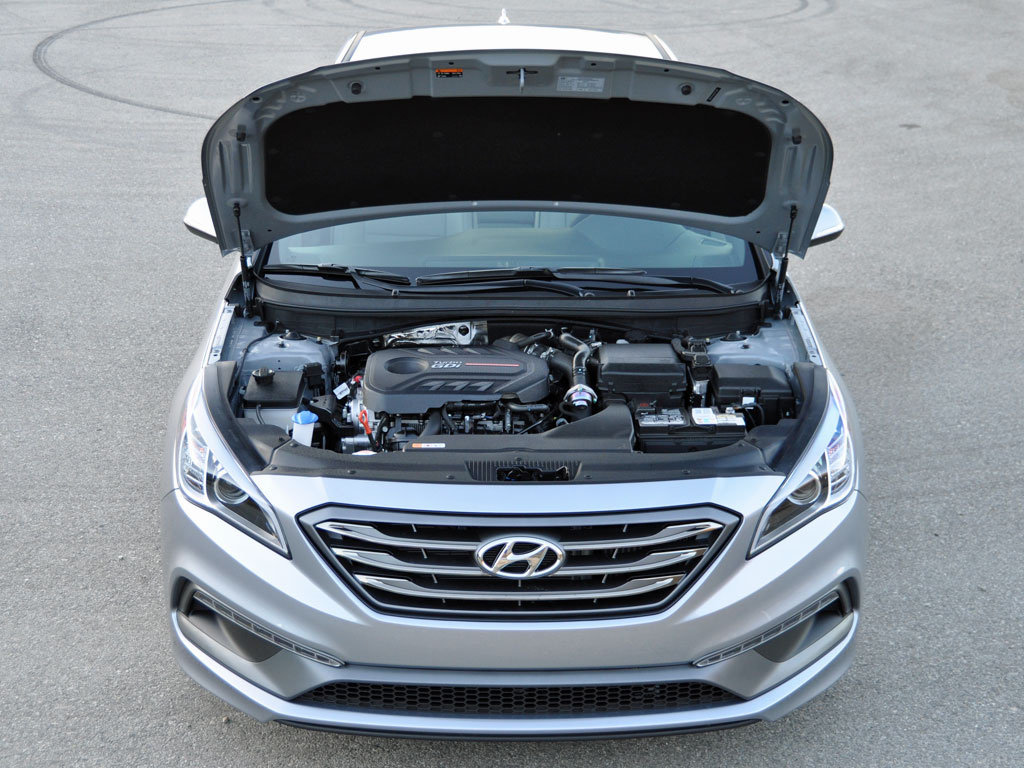
Have you ever stood in line outside a nightclub, waiting for the doorman to let you slip past the red velvet rope? You can almost feel the bass line of the music, you can faintly hear the laughter and shrieks of revelers inside. You know you're going to have a good time—if you could just get into the place and check it out.
Driving the sport-tuned Hyundai Sonata 2.0T down a twisty mountain road is like waiting in line outside a popular club, only to be denied entrance. You get a sense that there might be a good time ahead, but it never quite materializes.
The turbocharged 2.0-liter 4-cylinder engine isn't the problem. It makes 245 hp at 6,000 rpm, but what's more impressive is its 260 lb-ft of torque starting at just 1,350 rpm and lasting all the way to 4,000 rpm. That low and broad torque curve makes turbo lag barely perceptible and provides robust, linear power across the engine's rev range, especially if the driver switches the Drive Mode Select button from Normal to Sport.
An Eco mode is also available to the driver, muting the amount of whoosh the engine delivers. Push harder on the accelerator pedal, and your right foot easily overrides the software controlling transmission shift points. On my test loop, switching between Drive Mode Select's various settings but mainly using Normal mode, the Sonata Sport 2.0T returned 25.5 mpg, falling just a little bit short of the EPA's estimate of 26 mpg in combined driving.
A 6-speed automatic transmission feeds the engine's power to the car's front wheels. It's a terrific transmission as long as you don't shift your own gears using the manual shift gate or the paddle shifters located on the Sport 2.0T's flat-bottom steering wheel. Neither produces the snappy shifts associated with a true sport sedan, and the engine doesn't automatically match revs when downshifting. Therefore, to avoid disappointment, just leave the car in Drive.
Hyundai also endows the Sport 2.0T with rack-mounted electric steering instead of the column-mounted unit on the standard Sonatas. Does this improve the steering feel? Yes. Is there work to do in terms of sharpening response and heightening sensation? Absolutely, and this is an area where Hyundai has struggled for years.
A sport-tuned suspension is also standard for turbocharged versions of the Sonata, one that produces a noticeably firm ride. As long as you're expecting that, and desire that, you won't have any issues with how much road-surface detail gets transmitted to the cabin. If you're not in that camp, skip the Sonata 2.0T models.
Personally, I like the tauter ride and more capable handling characteristics, but I'd consider swapping the standard P235/45R18 Kumho Solus tires for something more aggressive. They give up pretty early, making for unexpectedly low cornering limits. It doesn't take much to coax understeer out of the car in tighter corners. Plus, they transmit a fair amount of road noise.
On a positive note, I had no complaint with the Sport 2.0T's brakes, but then it was a relatively cool day with temperatures in the mid-70s, and the squishy tires meant the car couldn't be driven very hard.
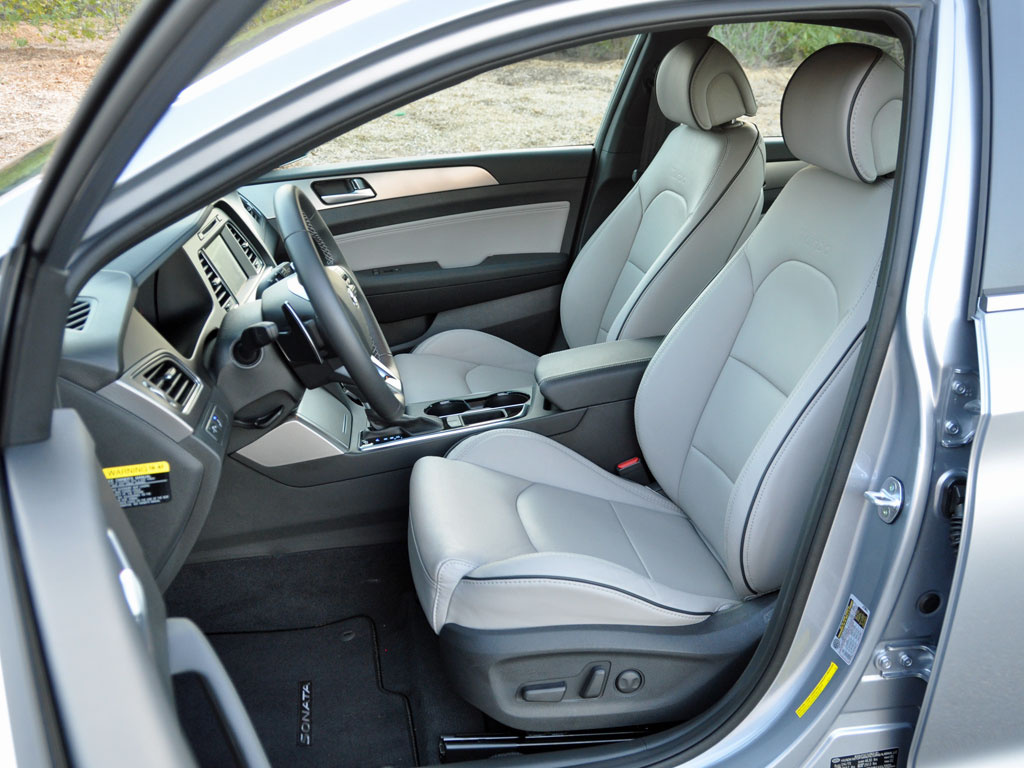
Considering that the Sonata Sport 2.0T is priced at less than $30,000, the quality and execution of the car's interior exceeds expectations. From the sheen, surface detailing, and panel fits to the appealing 2-tone appearance of the cabin, you definitely feel like you're getting more than you're paying for, even if the leather upholstery feels a little tough and unrefined.
One of my favorite things about the Sonata's interior is the center control panel. It is wide, with lots of clearly marked buttons and knobs, and the design groups the controls in a logical way. The touchscreen infotainment system is used occasionally rather than regularly, and the result is a minimum level of distraction while driving. Take a bow, Hyundai, because you've earned it.
Like the dashboard controls, the instrumentation is rendered in simple and clear fashion, making it easy for the driver to find and reference information.
Turbocharged Sonatas have sport-bolstered front seats, and the difference is subtle but palpable. My test car's tilt/telescopic steering wheel, combined with an 8-way power adjustable driver's seat and a generously sized bottom cushion with lots of thigh support, made it easy to get comfortable in this car. Hyundai also supplies a manual front passenger seat height adjuster, helping to improve comfort and ease of entry and exit.
Rear seat space is enormous. With the driver's seat set to my preference, I hopped in the back and had plenty of room to cross my legs, which require 33-inch inseam pants. I wasn't crazy about how soft and low the bottom seat cushion was, but that's a matter of personal preference.
Hyundai also gives the Sonata one of the largest trunks in the midsize family sedan segment, measuring a generous 16.3 cubic feet. My test car had the Smart Trunk feature, which automatically opens the lid if it senses the key fob within its proximity. If you don't want this feature, you can turn it off by accessing the proper menu in the driver information display.
Although my Sport 2.0T test car did not have them, it's worth noting that if you upgrade to the Limited 2.0T, you'll get heated and ventilated front seats, heated rear seats, a heated steering wheel, and rear side window sunshades, which are great to have when you've got small children in the car, especially babies riding in rear-facing child safety seats.
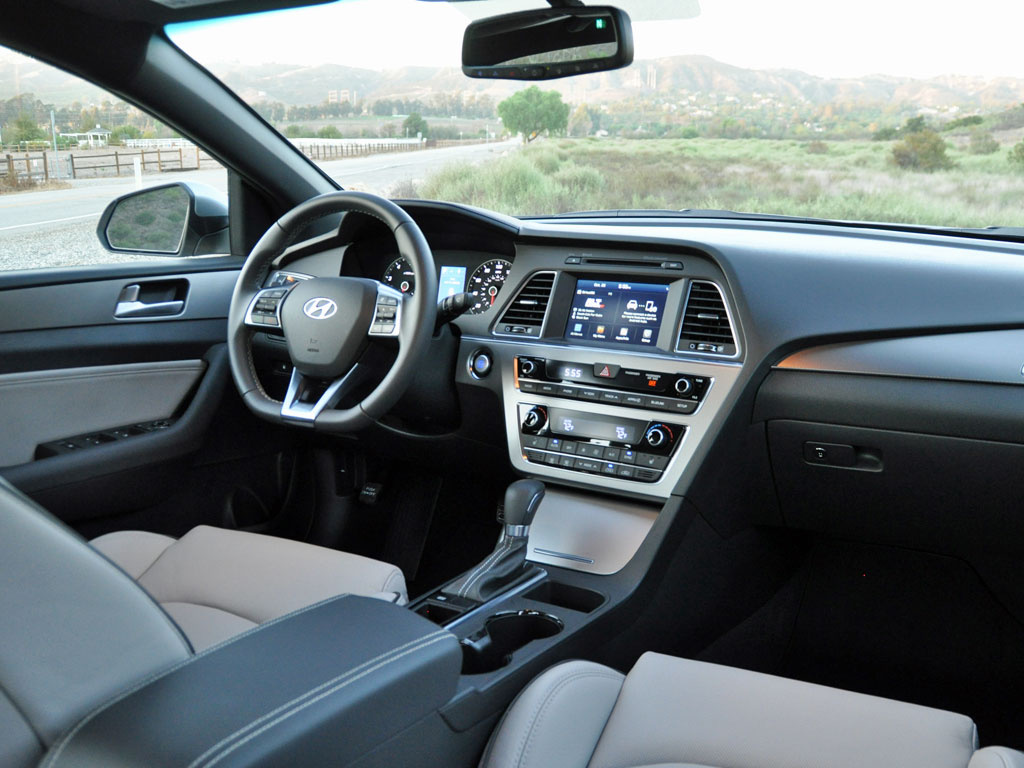
Because the Sport 2.0T trim level represents the affordable version of the turbocharged Sonata, my test car didn't have many bells and whistles. A navigation system, a premium sound system, and upgraded instrumentation are offered for the Limited 2.0T.
As for my test car's relatively simple infotainment system, I had no trouble pairing my iPhone 6 to the Bluetooth system, but on the day after pairing, the car didn't automatically recognize my phone, despite the fact that I had made it the primary device for the system. Also, while Android Auto smartphone integration technology is standard in all Sonatas, it obviously didn't play nice with my Apple device.
Hyundai also installs Blue Link subscription services technology in every Sonata. Free at first, Blue Link supplies access to automatic collision notification, SOS emergency assistance, remote start and door-lock access, and stolen-vehicle recovery service. More important to parents of teenage drivers, Blue Link allows Mom and Dad to program speed and curfew alerts, as well as to set geographic driving boundaries.
These features are free for a minimum of 3 months, and then owners need to pay a monthly or annual subscription. This is a different model from Hyundai's sister brand, Kia, which provides these types of services for free as long as a paired smartphone is aboard the vehicle.
Yeah, umm, the free stuff is better, so check out the redesigned 2016 Kia Optima.
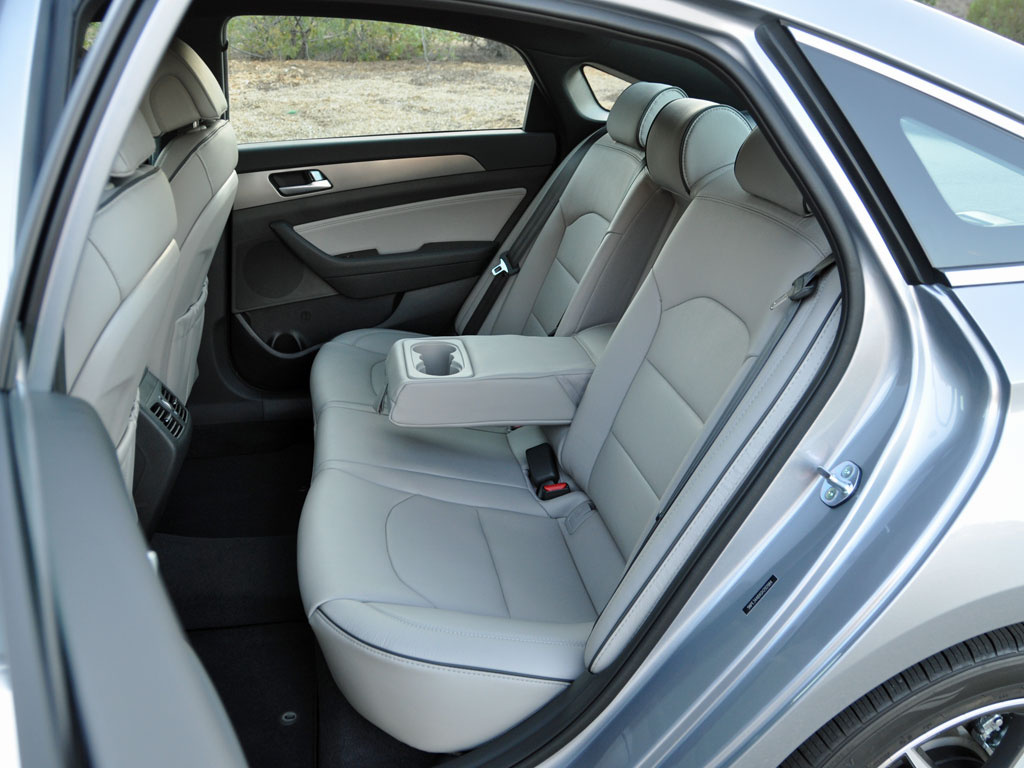
My Sonata test car had blind-spot warning and rear cross-traffic alert systems, the two modern safety technologies my wife and I both think are most useful to the average driver.
Hyundai's approach with its blind-spot warning system is perfect. If another vehicle is alongside the Sonata, the blind-spot warning system shows a warning light on the side mirror, where the driver is already looking prior to changing lanes. If the driver signals a lane change anyway, the light flashes and a warning sound makes it clear to the driver that changing lanes would be a bad idea.
If you upgrade to the Limited 2.0T, the Sonata comes with a forward-collision warning system and an automatic emergency braking system. The efficacy of these technologies is proven to reduce accidents, injuries, and deaths, and the Insurance Institute for Highway Safety (IIHS) says the Sonata's technology provides a Superior level of performance. More than anything, this is a great reason to upgrade to the Limited 2.0T model.
Additionally, the Limited 2.0T features an adaptive cruise-control system, adaptive high-beam headlights, a lane-departure warning system, and rear parking-assist sensors. Unfortunately, this equipment also necessitates installation of a different grille, one with a big black plastic panel on it, which ruins the car's facial aesthetics.
If an accident proves unavoidable, the Sonata does a great job of protecting its occupants. In testing conducted by the National Highway Traffic Safety Administration and the IIHS, the Sonata earns the highest possible ratings in every evaluation, with two exceptions.
First, this car gets an Acceptable rating in the small overlap frontal-impact test, one level down from a Good rating. This means the 2016 Sonata will lose its Top Safety Pick rating for the 2016 calendar year. Second, the Sonata gets a 4-star rollover resistance rating instead of 5 stars, but that's typical of the midsize sedan class and nothing to worry about.
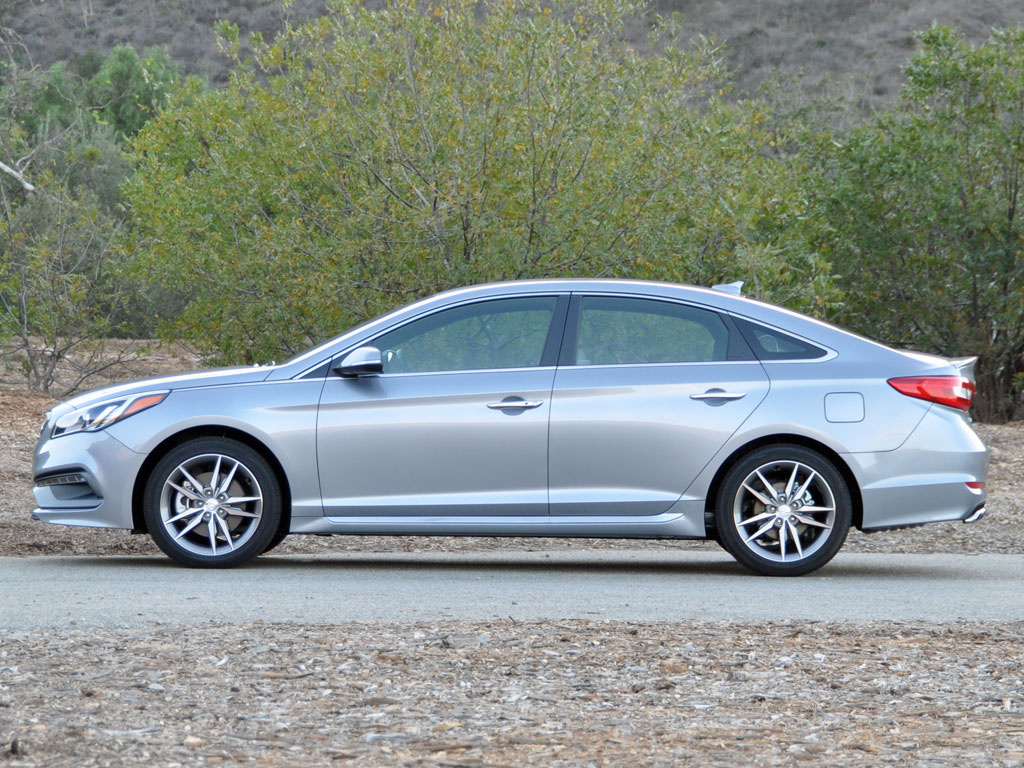
Fairly priced and offering a compelling value equation, buying a 2016 Hyundai Sonata is smart.
A combination of regularly offered deals and low cost of ownership makes the Sonata appealing, as does its industry-leading warranty and roadside-assistance program. Based on Consumer Reports and J.D. Power data, the Sonata's reliability and quality levels rate better than average, and though resale values aren't a strong point, it's important to remember that you're probably getting a pretty good discount on the price in the first place.
For example, as this review is written at the end of October of 2015, Hyundai is clearing out leftover inventory of the 2015 Sonata. Rebates are as high as $3,000, or $1,500 if you decide to take advantage of zero-interest financing for 60 months. You can even extend the loan to 72 months if you're willing to pay a 0.9% interest rate. Lease deals are available, too.
Take advantage of these kinds of deals, and you'll be getting a terrific midsize family sedan. Though this Sonata Sport 2.0T didn't inspire an emotional reaction from me, my sister-in-law sure loves her Sonata Limited, and lately, every time I see her, she tells me that it's the best car she's ever owned.
Ultimately, that's what matters.
Source: https://www.cargurus.com/Cars/2016-Hyundai-Sonata-Overview-c24889
0 Response to "2016 Hyundai Sonata Easy to Work on"
Post a Comment